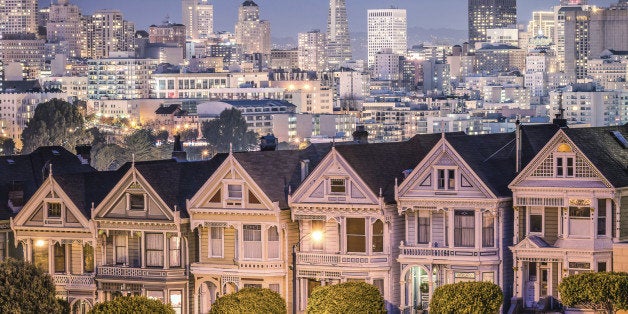
In front of the glowing new offices of Twitter on the edge of the Tenderloin, I watch the programmer step over the soiled, jean-clad legs of the homeless man lying on the sidewalk. As I descend into the underground BART station at Civic Center, I see a tired young woman who looks like a high school English teacher. Her heavy satchel is stuffed with essays as she stands in line for her 90-minute return commute to more affordable housing in Concord, 30 miles to the east. Her salary falls woefully short of what would afford her rent for a modest San Francisco apartment.
To know San Francisco today, to live here, to work here, is to bear witness to a growing inequality, a divergence in economic fortunes and real incomes. As a toddler I learned to walk on the jazzed-enveloped sidewalks of the Fillmore, a street I now cross each day coming to work at the oldest university in the city, where I teach economics. San Francisco has grown and has prospered in so many ways since my childhood. But today in the greatest of ironies, San Francisco is filled with the ravaged victims of its own unbridled economic prosperity.
Inequality in San Francisco, and perhaps other cities like it that have experienced tech booms, has dramatically increased through a confluence of forces which I will call (in highly technical economics terms) the "tractor beam," the "idea hatchery" and the "internet megaphone".
Workers who are imaginative, creative and possess strong technical skills are pulled toward San Francisco as if drawn by a high-energy economic tractor beam. This is because their productivity and wages are highest when their super-skills are matched with other super-skilled workers. This phenomena is something economists call complementarities. Complementarities happen when somebody's skill as a human interface specialist matches up with a high-end programmer to create lucrative company products like Uber, Dropbox, Airbnb and Yelp.
The second economic force is the "idea hatchery." When groups of exceptionally creative and talented people work together, big ideas are hatched, big ideas that make a lot of money. It is only rare geographical places in the world that become big idea-hatching regions on a grand scale. San Francisco has become one of these places. This makes the rewards from location grow exponentially, pumping greater energy into the economic tractor beam.
The third force is of course the internet, which acts like a giant megaphone for technological creativity. We often think of the internet as a friend of the little guy, of the disadvantaged, the great playing field leveler. That's a pleasant narrative, but it really isn't. One of the effects of the internet is that it significantly amplifies the remuneration to the talents of the super-skilled relative to the less-than-super-skilled.
For decades now, economists have understood how broadcast and recording media have allowed, for example, the most popular musicians and actors to earn super-star incomes through the mass marketing of their talents. Contrast this with centuries gone by when the most popular traveling bards and drama troupes could only perform live in local village markets, thereby earning them only a modest wage. Like actors during the advent of recorded motion pictures, the internet now allows super-star programmers to broadcast their skills to a massive global market.
So how do the confluence of the economic tractor beam, the idea hatchery, and the internet megaphone affect existing workers in local markets? The increased demand does benefit some local businesses, but everyone needs a place to live, and technology developers earning high returns from the global market compete over San Francisco's scarcest commodity: land. Fueled by the global market for locally developed technology, this competition propels the price of the available housing to Himalayan heights, giving rise to the $5,000/month two-bedroom apartment, the $2 million two-bedroom home, and an intractable homelessness problem that becomes even more costly to address.
Another irony to the growing inequality in San Francisco is that the policies of the city's liberal activists, ostensibly seeking to reverse inequality in San Francisco, have achieved precisely the opposite result -- they have profoundly exacerbated it. There is no better solution for putting downward pressure on rents and home prices in cities like San Francisco than building large quantities of high-rise affordable housing near work sites and transit centers. But rather than seeing this as an environmentally friendly solution that would simultaneously reduce urban sprawl, traffic congestion, and put downward pressure on rents, so-called progressives chose to cast their lot against the "rich developers" and city planners who have advocated this approach for decades.
There have also been unhelpful narratives that have forestalled the creation of more housing. Leading city planner William Fulton has worried, for example, that building more affordable housing in San Francisco will lead to a situation in which "more smart kids will show up wanting to work for tech start-ups, and that means you'll have more tech start-ups, and pretty soon demand will rise faster than supply" (which by the way sounds like exactly what many American cities are trying to achieve rather than prevent). But this assumes that the idea hatchery can be shut down by reducing the housing supply, a sketchy economic proposition at best. Clearly a more sensible approach is to continue to plan for environmentally friendly, high-density housing until the era when the idea hatchery slows down its hatching, or moves to another city.
Cities like San Francisco can also do more to address local inequality by investing in the skills of current residents left out of the tech boom, helping them to develop the hard and soft skills needed to compete effectively with outsiders for jobs in the dynamic local firms. Every local resident hired for a local tech job reduces the upward pressure on housing prices from migratory inflow. For the long term, better early childhood education is a proven means for successfully equipping children for adult participation in a modern economy.
Growing urban inequality has become one of the great features of American cities today. It is one of the most important factors fueling hopelessness, violence, and the growing tension between police and urban residents. How to harness the economic forces of technology booms to foster a higher quality of life for city residents more broadly is one of the greatest challenges today for American urban leadership.
Bruce Wydick is Professor of Economics at the University of San Francisco and Research Affiliate at the Center for Effective Global Action at the University of California at Berkeley. Follow him on Twitter @BruceWydick.
